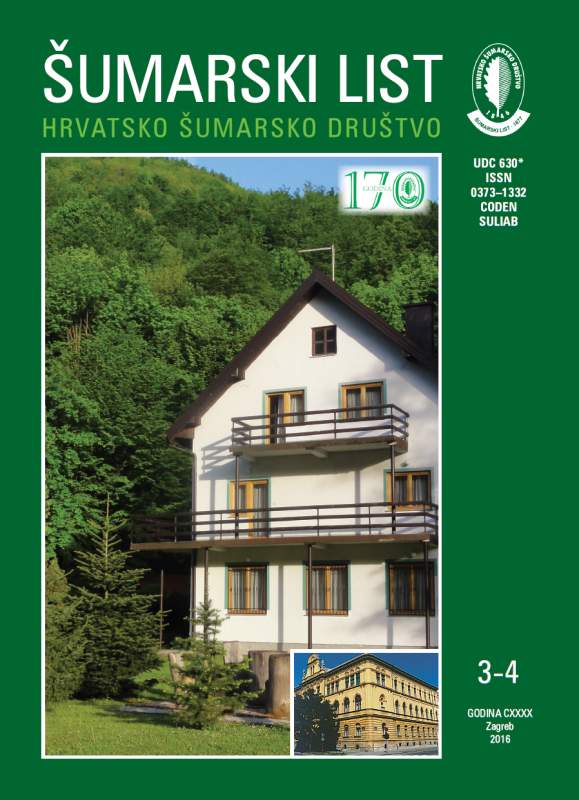
broj: 3-4/2016
pdf (14,09 MB) |
|
||||||||||||||
| RIJEČ UREDNIŠTVA | ||
| Uredništvo | ||
| IT IS TIME TO FINALLY FORMULATE A CONSISTENT FORESTRY POLICY AND FORESTRY STRATEGY pdf HR EN | 109 | |
| IZVORNI ZNANSTVENI ČLANCI | ||
| Jozo FRANJIĆ, Gabrijel HORVAT, Daniel KRSTONOŠIĆ | UDK 630* 111 + 113 (001) | |
| NEW LOCALITIES AND SYNTAXONOMIC CHARACTERISTICS OF SEA BUCKTHORN (Hippophaë rhamnoides L., Elaeagnaceae) IN CROATIA pdf HR EN | 111 | |
| Ivan ANDRIĆ, Igor POLJAK, Marno MILOTIĆ, Marilena IDŽOJTIĆ, Davorin KAJBA | UDK 630* 165 + 111 (Fraxinus angustifolia Vahl) (001) | |
| LEAF PHENOLOGY CHARACTERISTICS OF NARROW-LEAVED ASH (Fraxinus angustifolia Vahl) IN CLONAL SEED ORCHARD pdf HR EN | 117 | |
| Summary Narrow-leaved ash (Fraxinus angustifolia Vahl) is a hygrophilic and predominantly thermophilic tree species that favours deep, clayed and moist soils exposed to occasional seasonal flooding. The largest complexes of narrow-leaved ash (80 %) are located along the Sava river. In the context of global climate change, it is important to know the composition and structure of genetic variability, particularly in terms of adaptive potential such as growth, survival and leaf phenology. The goal of research was to analyze the beginning of the leaf unfolding phase (L2 phase), the duration of leaf development (L2 – L6) and the impact of atmospheric parameters on the beginning of leaf unfolding, as well as to determine intrapopulation and interpopulation variability and the existence of ecotypic forms in relation to the beginning of leaf unfolding. Phenological characteristics of leaf phenology of narrow-leaved ash were monitored in the clonal seed orchard of Nova Gradiška in the course of three years of research (2012, 2014 and 2015). Monitoring included 42 clones originating from three populations (Jasenovac, Novska and Stara Gradiška). Every clone was represented with four ramets each (in total 168 plants). Leaf development was divided into six phenophases (figure 2, table 1); the analysis focused exclusively on Phase L2 (beginning of leaf unfolding). The average number of days from January 1st to the beginning of leaf unfolding was 98 days in 2012, 93 days in 2014, and 103 days in 2015 (figure 3, table 2). The average number of days required for leaf development amounted to 27 days in 2012, 26 days in 2014 and 20 days during 2015. Based on phenological results throughout the three years of study, the clones were divided into two ecotypic forms (early and late) with regard to the beginning of flushing (figure 5, table 4). The justification of division into two forms was statistically confirmed (table 3). The average values of the number of days for early ecotypic forms ranged from 90 to 101 days, and for late forms from 99 to 107 days. Along with temperature requirements as the most crucial activating factor in the manifestation of leaf phenology, researche also confirmed high correlation between cumulative values of precipitation quantity (from December 1st to the beginning of Phase L2) and the beginning of leaf unfolding in narrow-leaved ash (r=0,93). Statistically significant differences were found between all the studied clones, and so were for intrapopulation variability for the beginning of leaf unfolding; however, no statistically significant differences were found between the studied populations (table 3). Intraclonal values of the coefficient of variability (CV %) for the property of leaf unfolding decreased with the age of the experiment and on average amounted to 15.22 % at age 2 + 8 years, 13.46 % at age 2 + 10 years, and 7.8 % at age of 2 + 11 years, indicating higher stability and uniformity of phenological characteristics among the ramets as their age increased (figure 4). The affiliation of the clones to ecotypic forms did not coincide with their geographic origin, which additionally confirmed important intrapopulation variability of narrow-leaved ash. Key words: narrow-leaved ash; leaf unfolding; precipitation; intrapopulation and interpopulation variability; intraclonal variability; early and late ecotypic forms | ||
| Dalibor BALLIAN | UDK 630* 443 (001) | |
| GENETIC STRUCTURE OF SESSILE OAK (Quercus petraea (Matt.) Lieblein) IN BOSNIA AND HERZEGOVINA BASED ON THE ISOENZYME ANALYSIS pdf HR EN | 127 | |
| Emsud SELMAN, Mirza DAUTBAŠIĆ, Osman MUJEZINOVIĆ | UDK 630* 453 (001) | |
| SMALL SPRUCE LEAF WASP (Pristiphora abietina Christ. 1791) – CONTRIBUTION TO THE BIOLOGY OF PEST IN THE VIEW OF NEWLY DAMAGES pdf HR EN | 137 | |
| PRETHODNO PRIOPĆENJE | ||
| Neška VUKŠIĆ, Marcela ŠPERANDA | UDK 630* 114.2 | |
| DISTRIBUTION OF HEAVY METALS (Cd, Pb, Hg, As) AND ESSENTIAL ELEMENTS (Fe, Se) IN FOREST SOIL AND PLANT COMMUNITIES OF THE STATE OPEN HUNTING AREA ˝KRNDIJA II˝ XIV/23 pdf HR EN | 147 | |
| PREGLEDNI ČLANCI | ||
| Atinc PIRTI, Nursu TUNALIOGLU, Taylan OCALAN, R.Gursel HOSBAS | UDK 630* 582 | |
| AN ALTERNATIVE METHOD FOR POINT POSITIONING IN THE FORESTED AREAS pdf HR EN | 155 | |


